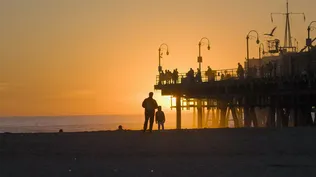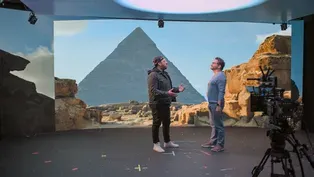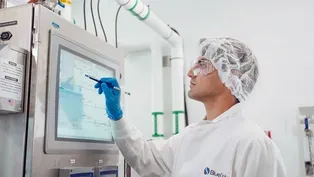
An Argument for a More Inclusive, Empowering Climate Story
Clip: Episode 3 | 9m 13sVideo has Closed Captions
Ellen MacArthur advocates for a more sustainable, circular economy model.
Climate scientist Katharine Hayhoe advocates for more inclusive narratives around climate action, emphasizing the importance of storytelling in bridging political divides and fostering empathy among people. By shifting from a linear economy to a circular one, a new story about sustainability and prosperity emerges.
Supported by the Hoveida Family Foundation and The Rosalind P. Walter Foundation.

An Argument for a More Inclusive, Empowering Climate Story
Clip: Episode 3 | 9m 13sVideo has Closed Captions
Climate scientist Katharine Hayhoe advocates for more inclusive narratives around climate action, emphasizing the importance of storytelling in bridging political divides and fostering empathy among people. By shifting from a linear economy to a circular one, a new story about sustainability and prosperity emerges.
How to Watch A Brief History of the Future
A Brief History of the Future is available to stream on pbs.org and the free PBS App, available on iPhone, Apple TV, Android TV, Android smartphones, Amazon Fire TV, Amazon Fire Tablet, Roku, Samsung Smart TV, and Vizio.
Buy Now

What It Means to Be Human
A Brief History of the Future explores the human ability to increase empathy and compassion, what values we are instilling into artificial intelligence technologies, and the need to create both a better world and a better humanity for life to flourish on this planet.Providing Support for PBS.org
Learn Moreabout PBS online sponsorship[soft music] - When it comes to the biggest stories of our time, the challenge we face is in finding ways to communicate that can cut through the differences that divide us.
And in a moment when these divides seem to only be growing, the role of storytelling is more important than ever.
I came to Texas to meet Katharine Hayhoe, an evangelical Christian and climate scientist who's focused on building bridges to change the story around climate action to be a whole lot bigger and more inclusive than the one we've been telling.
- According to Pew Research, the United States is more politically divided today than it's been since the Civil War.
Our political ideology is often the number-one predictor of what we hold as our identity.
And in this type of divisiveness, what we see is that people start to view others who vote differently than themselves as not even human, as enemies, rather than fellow citizens.
- So how do we start bridging these divides that are tearing our country apart?
- Only if we start with what we have in common, not if we begin with what divides us.
And storytelling is a huge part of that.
So neuroscientists have found that when we tell a story, that people's brainwaves actually synchronize with each other, and we empathize much more strongly, because we can see ourselves in that situation, in that story.
- Katharine spends a lot of her time these days speaking to people who don't traditionally see themselves as a part of the climate movement.
For her, it's about telling a story that people can actually see themselves in.
- All of us--almost all of us, I should say-- have two big problems when it comes to climate change.
We don't understand why it matters to me, here and now, and we don't know what we can do to fix it, or we think we do know, and we don't want to do it.
There's names for these two things.
The first one's called "psychological distance," and the second one is called "solution aversion."
You can't eat meat.
You can't drive a truck.
You can't travel.
You can't have kids.
Everybody has to sacrifice to fix climate change.
And I'm like, "Well, if that's your only solution, we're never gonna do it."
We've been told that all climate solutions involve loss, sacrifice, suffering, something being taken away from us, rather than gaining anything, and our human brains are wired to be more fearful of loss than we appreciate gain.
And so we're working against the wiring of our brains.
We need the best choice to also be the easiest choice and the most affordable choice, the default choice, the natural choice.
And to make that happen, we need system change.
I was in the studio, recording the audio version of my book.
So I went into the booth, and I recorded the first few hours, and then I came out to take a break, and the sound engineer said, "I didn't realize your book is about climate change.
I have some questions."
[laughs] So I said, "All right, here we go."
So we sat down.
But instead of him asking me questions, I started by asking him questions.
"How long have you lived here?
Do you have family?"
"Yes, kids and grandchildren."
You know, "What are the types of things you enjoy doing here?"
Pretty soon, he was telling me about how he grew up going to this lake to go fishing, how he wants to take his grandchildren there, but how the lake has been getting warmer, and it's clogged with algae now, and there's not nearly as many fish, and there's so much development around it.
I was listening to his experiences, not him listening to mine.
And so when it got to the point where he had questions, at that point, his questions were, "Well, but what are we supposed to do about this?
"Because the only solutions I've heard are these liberal solutions, and I'm not a liberal."
So I got a chance to talk about how there are conservative and bipartisan solutions that people do agree on and give him some resources where he could find out more about that.
The story we're missing is that of a better future.
Climate change stands between us and a better future.
It's not just about avoiding the apocalypse.
It's about implementing changes that will clean up our air and our water and give us a safer place to live and ensure abundant food for all and improve our health and give us that safe world that we all want.
If we don't visualize and imagine and tell ourselves stories of what we want that world to look like, how are we ever gonna get there?
♪ ♪ - One story we tell ourselves, which is perhaps the biggest fairy tale of all, is the story of infinite growth on a finite planet, that we can just keep growing and growing and growing the economy, and somehow, the world will accommodate that.
And people say, "Well, we're not asking for the Earth.
We only want 3% growth a year."
Well, 3% growth means a doubling of all economic activity every 24 years.
So in the whole of human history, that then gets doubled.
Then 24 years later, it gets doubled again and again and again.
But of course, we very quickly start to bump into environmental limits.
♪ ♪ - These limits raise all kinds of questions about the stories on which much of the modern world has been built.
And as it becomes clear just how unsustainable this all really is, what kind of alternative story can we begin writing in this moment?
That's led me to London, where a former sailor turned economist named Ellen MacArthur is working to prove that a new story is not only needed, but possible.
Take me on the journey from a world record-holding sailor to circular economics.
How did you get to this point?
- First of all, I never thought I would be at this point.
You know, when I sailed when I was four years old, that was all I ever wanted to do.
I love being at sea.
I love watching all around me.
I love being connected to everything around me.
And it was like a drug.
I just wanted to do more and more.
And that very quickly, actually, led me to sail around the world for the first time when I was 23 years old.
I am looking forward to getting out there on my own, and it's been a great year racing with the crew, and also racing on different boats.
But no, I still love sailing on my own.
This is a massive challenge.
This is the ultimate record, the fastest around the world record.
When you sail around the world on a boat, you take with you what you need for your survival for three months.
And when you start, you watch those resources go down every single day.
There is no more.
What you have is all you have, and you develop this overwhelming understanding of what it is to have finite resources.
You know what it means to have no more.
And I suddenly translated that to the global economy.
We tend to take something out of the ground, make something out of it, and then throw it away, so that needs a continuous flow of resources.
That can't run in the long term, when we have a growing world population and a growing economy.
The more I thought about it, the more I was fascinated by it.
I asked a lot of really dumb questions to lots and lots of people in the early days, just saying, "So how does this work, and what's the solution?"
What place are we trying to get to?
If we know we can't do this, then we need to do something different, so what is that thing?
I don't think linear economics ever happened because people were trying to use up all our resources.
It was a natural progression from the Industrial Revolution.
Now we know, in order to satisfy the needs of ourselves today and in the future, the whole economy has to operate in that circular way.
- What is circular economics?
- If you think about that linear straight line, if you, by design, turn that straight line into a circle, then you look at eliminating waste and pollution, you circulate products and materials, and you regenerate natural systems.
So it's not something you think about at the end, but as you build the economy, you design that into the economy so that it can run in the long term.
Some of the best circular examples are of carpet manufacturers.
They were completely tied to buying new raw materials to make their carpets with, and those prices were going up and up and up.
And they said, "Why do we need to buy "new raw materials when we can design our carpets in a circular way?"
So they redesigned the carpet.
They designed it so the base could be melted down and turned into the base for the next carpet.
The yarn could be extracted, re-spun, turned into the yarn of the next carpet, and actually, they offered it not to be sold, but leased.
So when those trucks come in to make the carpet, rather than being filled with raw materials from a mine or from an oil well, they're your carpets coming back in to be reprocessed.
And you design them, so you know what sits in them, and you design them, so you know how to get that out of it, and that would be that perfect circular example.
- What are some of the challenges facing us in shifting from linear to circular economics?
- I'd say one of the biggest challenges is mindset, because we've all come through a linear education system and we've inherited a linear economy.
It's easy to get buried in the problem, but we need to lift our heads out of the sand and say, "Where are we going?
Where do we want to get to?"
Because life is about opportunity.
Life is about those goals.
You want to know what you can do, and you want to be part of that.
Diverse and Impactful Storytelling to Reimagine Our Futures
Video has Closed Captions
Ari visits a VFX studio to witness how technology is expanding storytelling limits. (9m 59s)
Video has Closed Captions
How do the stories we tell shape the boundaries of our beliefs about what is possible? (30s)
Providing Support for PBS.org
Learn Moreabout PBS online sponsorshipSupported by the Hoveida Family Foundation and The Rosalind P. Walter Foundation.
















